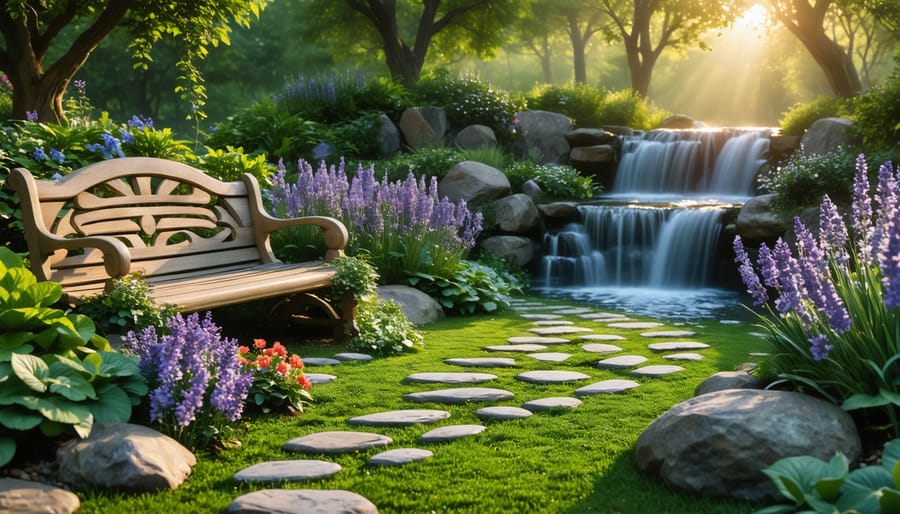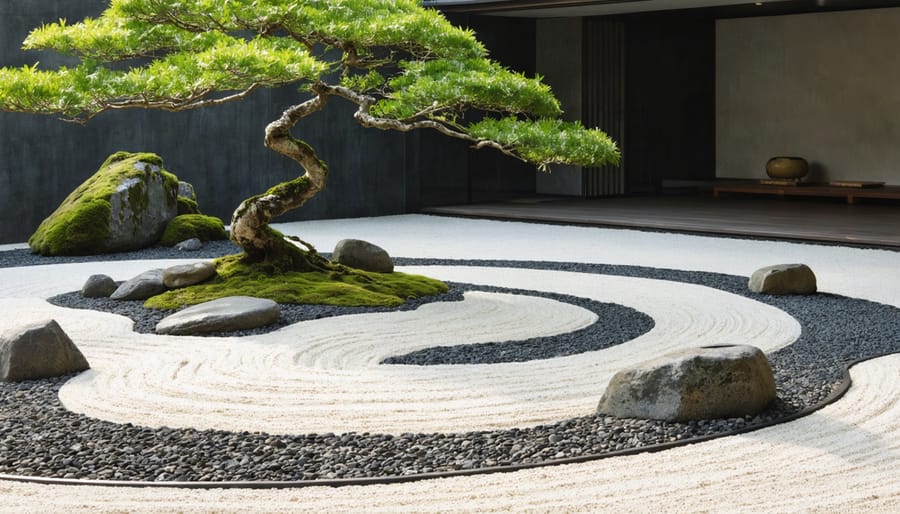Transform your garden into a sacred sanctuary where nature and spirituality intertwine, creating a personal haven for meditation, reflection, and inner peace. Spiritual gardens have served as spaces for contemplation across cultures for millennia, from Japanese Zen gardens to medieval monastery courtyards. Today, these mindful outdoor spaces offer a much-needed retreat from our fast-paced digital world.
Creating your own spiritual garden doesn’t require vast space or expert knowledge – it begins with intentional design choices that speak to your personal spiritual journey. Whether you’re drawn to the gentle sound of flowing water, the subtle fragrance of sacred herbs, or the symbolic placement of meaningful objects, each element can contribute to a space that nurtures both body and soul.
In this guide, we’ll explore how to design and maintain a spiritual garden that resonates with your beliefs while supporting sustainable practices and local ecosystems. From selecting plants with spiritual significance to incorporating meditation areas and natural features, you’ll discover practical steps to create a space that invites contemplation and fosters a deeper connection with nature. Let’s begin this transformative journey of creating your own sacred outdoor sanctuary.
Essential Elements of a Sacred Garden Space
Sacred Symbolism in Garden Design
Sacred symbols have long been used to create meaningful garden spaces that speak to our spiritual nature. When designing a meditation garden layout, incorporating symbolic elements can transform an ordinary space into a profound sanctuary for reflection and connection.
Consider the circle, representing unity and wholeness, which can be expressed through circular pathways or round garden beds. The spiral, found throughout nature, symbolizes growth and evolution, making it perfect for herb gardens or meandering paths. Creating a mandala pattern using plants or stones can serve as a powerful focal point for meditation.
Numbers also play a significant role in sacred garden design. Groups of three plants might represent body, mind, and spirit, while four corners can symbolize the classical elements: earth, air, fire, and water. Seven-pointed designs often reference celestial bodies, while eight-fold patterns appear in many spiritual traditions.
Water features can be arranged to flow from east to west, following the sun’s path, while stepping stones can be placed to encourage mindful walking. Consider incorporating sacred geometry through hexagonal raised beds or triangular planting schemes. These thoughtful arrangements not only create visual harmony but also inspire deeper contemplation and connection with nature.
Remember that symbolism is deeply personal – choose elements that resonate with your own spiritual journey while respecting universal design principles.
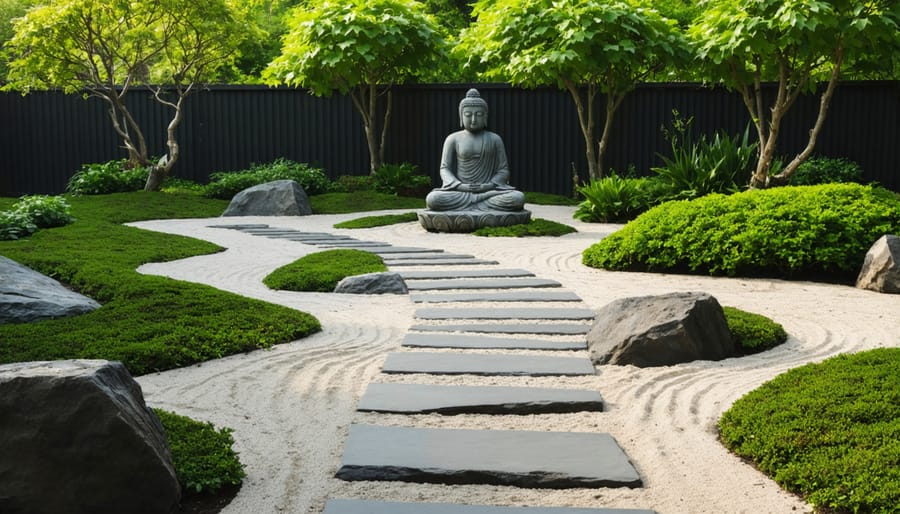
Choosing Plants with Spiritual Significance
When creating a spiritual garden, selecting plants with sacred significance can deepen your connection to the space. Many cultures throughout history have revered certain sacred and medicinal plants for their spiritual properties and healing abilities. Consider incorporating plants like lavender, known for its calming properties and ability to promote peaceful meditation, or white sage, traditionally used for cleansing and purification rituals.
Lotus flowers, despite requiring specific growing conditions, symbolize enlightenment and purity in many Eastern traditions. For easier alternatives, consider water lilies or iris varieties that offer similar symbolic meaning. The peaceful olive tree represents wisdom and peace, while rosemary has long been associated with remembrance and clarity of mind.
For those drawn to Native American traditions, sweetgrass creates a gentle, grounding presence in the garden. Cedar, another sacred plant in many cultures, offers year-round greenery and protective energy. Don’t overlook the humble marigold, which holds deep spiritual significance in various traditions and adds vibrant color to your space.
Choose plants that resonate with your personal spiritual practice and grow well in your climate. Remember that the most meaningful choices are often those that speak to your own spiritual journey while thriving in your garden’s conditions.
Creating Mindful Garden Features
Water Elements for Tranquility
Water elements are essential in creating a spiritual garden, bringing a sense of peace and tranquility through their gentle movement and soothing sounds. When designing garden water features, consider starting with a simple fountain as your centerpiece. The sound of flowing water naturally calms the mind and creates an instant meditative atmosphere.
A small reflecting pool can serve as a mirror to the sky, encouraging contemplation and self-reflection. Position it where it can catch glimpses of sunlight or moonlight, creating magical moments throughout the day. For those with limited space, even a ceramic bowl with water and floating flowers can create a powerful spiritual focal point.
Waterfalls, whether natural-looking or contemporary in design, add vertical interest and create white noise that helps mask urban sounds. Consider incorporating smooth river stones around your water features to enhance the natural feel and provide comfortable seating areas for meditation.
For sustainability, install a recirculating pump system to conserve water. Add aquatic plants like water lilies or lotus flowers, which hold deep spiritual significance in many traditions. These plants not only beautify your water feature but also help maintain water quality naturally.
Remember to position your water features where you can easily hear them from your favorite garden spots, allowing their peaceful sounds to enhance your outdoor sanctuary.
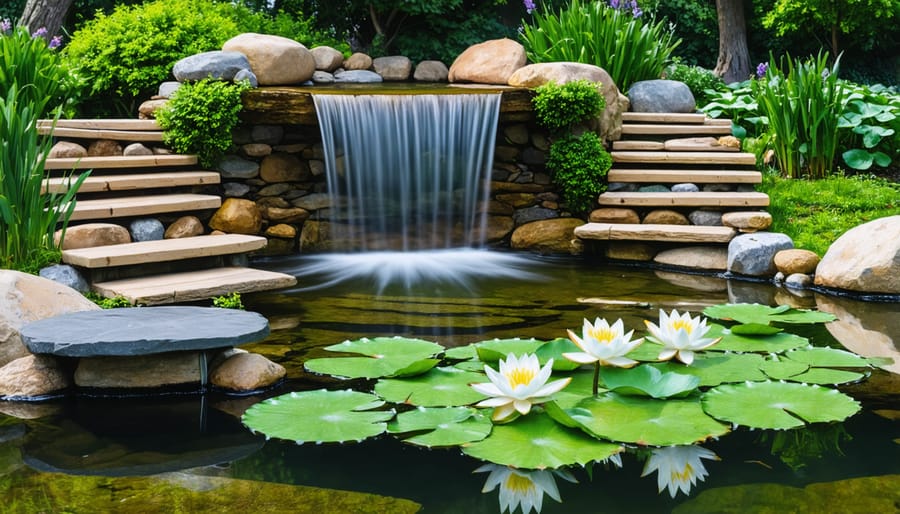
Meditation Areas and Seating
Creating a comfortable meditation area is essential for any spiritual garden. A well-designed seating space invites quiet contemplation and allows you to fully immerse yourself in the garden’s peaceful atmosphere. Consider placing a sturdy bench or weatherproof chair in a sheltered spot that offers both privacy and an inspiring view of your garden elements.
Natural materials like stone, wood, or bamboo create harmony with the surrounding environment. A simple wooden platform or deck can serve as an elevated meditation space, while large, flat rocks or stumps make excellent informal seating options that blend seamlessly with the landscape. For added comfort, incorporate weather-resistant cushions in earthy tones or soft pastels.
Create intimate nooks by surrounding seating areas with tall grasses or flowering shrubs. These natural screens provide privacy and gentle rustling sounds that enhance meditation. Consider adding a small table or shelf nearby to hold meditation aids, books, or a cup of tea.
Placement is crucial – position seating to capture morning sunlight or afternoon shade, depending on your climate and preferences. Some gardeners prefer multiple meditation spots to follow the sun’s path throughout the day or to experience different garden views and atmospheres.
For group meditation or small gatherings, arrange several seats in a circle or semicircle. This layout promotes connection while maintaining individual space for reflection. Remember to leave enough room for comfortable movement and consider adding stepping stones or a clear path leading to your meditation area.
Natural Sound Elements
Sound plays a vital role in creating a spiritual garden sanctuary, helping to deepen meditation and enhance relaxation. Water features are perhaps the most popular choice, offering a gentle symphony of trickling or flowing sounds that naturally calm the mind. Consider installing a small fountain, a cascading stream, or even a simple bamboo water spout to introduce these soothing elements.
Wind chimes add another layer of peaceful sounds to your garden. Choose deep-toned metal or wooden chimes that create gentle, melodious notes rather than sharp, high-pitched sounds. Placing them strategically around your garden allows the breeze to create an ever-changing musical experience.
Strategic planting can also contribute to your garden’s soundscape. Tall ornamental grasses rustle soothingly in the wind, while bamboo creates a distinctive gentle clicking sound as stalks touch each other. Consider planting trees that attract songbirds, such as berry-producing varieties, to encourage natural birdsong in your space.
Creating quiet zones is equally important. Use dense hedges or living walls to buffer noise from nearby streets or neighbors. Soft ground covers and mulch can help absorb unwanted sounds while providing a peaceful walking surface. Remember that sound travels upward, so varying the heights of your plantings and features can help create layers of gentle sound that enhance your spiritual garden experience.
Maintaining Your Sacred Space
Seasonal Care Rituals
Tending to a spiritual garden requires mindful attention throughout the changing seasons, each bringing its own unique opportunities for connection and growth. In spring, begin with a cleansing ritual by clearing winter debris while setting intentions for new growth. This is the perfect time to bless your garden tools and prepare the soil with organic matter, honoring the earth’s awakening.
Summer brings abundant energy, calling for regular early morning or evening meditation sessions while tending to your plants. Focus on sustainable watering practices, perhaps collecting rainwater in blessing bowls. Create natural pest deterrents using sacred herbs like lavender and rosemary, maintaining harmony without harsh chemicals.
As autumn approaches, express gratitude through harvest rituals, saving seeds from your most cherished plants, and preparing the garden for its winter rest. Collect fallen leaves to create nutrient-rich compost, viewing this process as nature’s cycle of renewal. Consider adding autumn-blooming flowers like chrysanthemums to maintain your garden’s spiritual energy.
Winter offers time for reflection and planning. Protect sensitive plants with natural mulch, and use this quieter season to maintain your garden structures, perhaps repairing meditation benches or wind chimes. Create winter interest with evergreens and ornamental grasses, reminding us that spiritual growth continues even in dormant times.
Remember to align your garden care with the moon phases throughout the year, as many gardeners find this ancient practice enhances their spiritual connection while promoting plant health.
Mindful Gardening Practices
Cultivating your spiritual garden becomes more meaningful when you embrace a mindful gardening approach. Instead of rushing through garden tasks, take time to connect with each activity, treating it as a moving meditation. Begin by focusing on your breath as you work, feeling the texture of soil between your fingers and noticing the subtle fragrance of plants around you.
When weeding, approach the task with intention rather than seeing it as a chore. Consider how removing unwanted growth mirrors clearing negative thoughts from your mind. As you water your plants, imagine you’re nurturing not just the garden but your own spirit, allowing peace to flow through you like the water through your watering can.
Pruning becomes an exercise in mindful decision-making. Before making each cut, pause to observe the plant’s structure and growth pattern. This thoughtful approach helps you make better gardening choices while practicing presence and patience.
Create daily rituals in your garden, such as morning meditation among your plants or evening gratitude walks. These practices help deepen your connection to nature and enhance your spiritual experience. Remember to engage all your senses – listen to birds singing, feel the breeze, and appreciate the changing colors and textures throughout the seasons.
Keep a garden journal to record your observations, feelings, and the subtle changes you notice. This practice helps develop awareness and creates a meaningful record of your garden’s evolution and your personal growth alongside it.
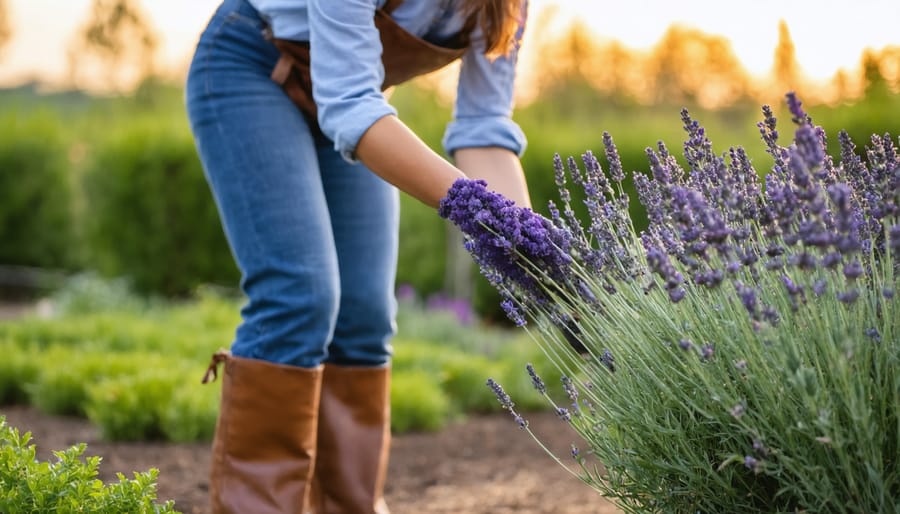
Creating and maintaining a spiritual garden offers a wealth of benefits that extend far beyond the physical act of gardening. As you nurture your sacred space, you’ll discover it becomes a sanctuary for personal growth, emotional healing, and spiritual connection. The mindful practice of tending to your garden can reduce stress, anxiety, and depression while promoting a deeper sense of peace and purpose.
Your spiritual garden serves as a living meditation space, where the simple acts of planting, weeding, and pruning become opportunities for mindfulness and reflection. The seasonal changes remind us of life’s natural cycles, teaching valuable lessons about patience, acceptance, and impermanence. Many gardeners report feeling more grounded and connected to nature through their daily interactions with their spiritual gardens.
The beauty of creating such a space lies in its ability to evolve with you on your spiritual journey. Whether you’re seeking solitude, inspiration, or a place for prayer and contemplation, your garden can adapt to meet your changing needs. The sustainable practices often employed in spiritual gardens also contribute to environmental stewardship, creating a positive impact that extends beyond your personal space.
Remember that your spiritual garden is a reflection of your inner world, and its benefits multiply as you invest time and energy into its care. As your garden grows and flourishes, so too will your spiritual well-being, creating a harmonious cycle of growth and renewal that enriches your life in countless ways.

